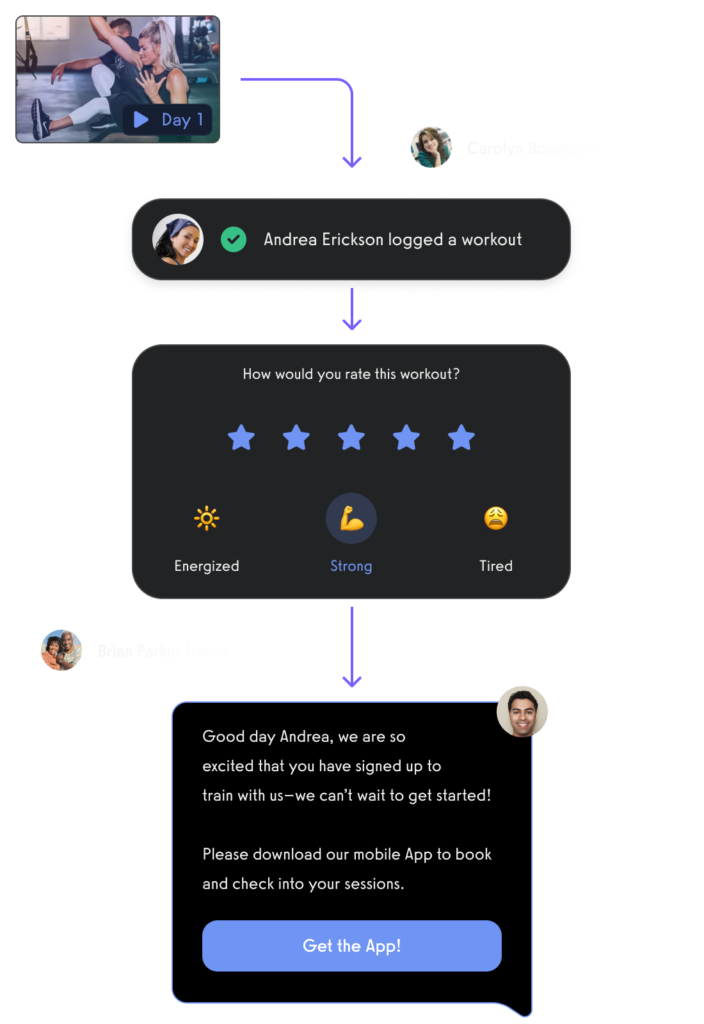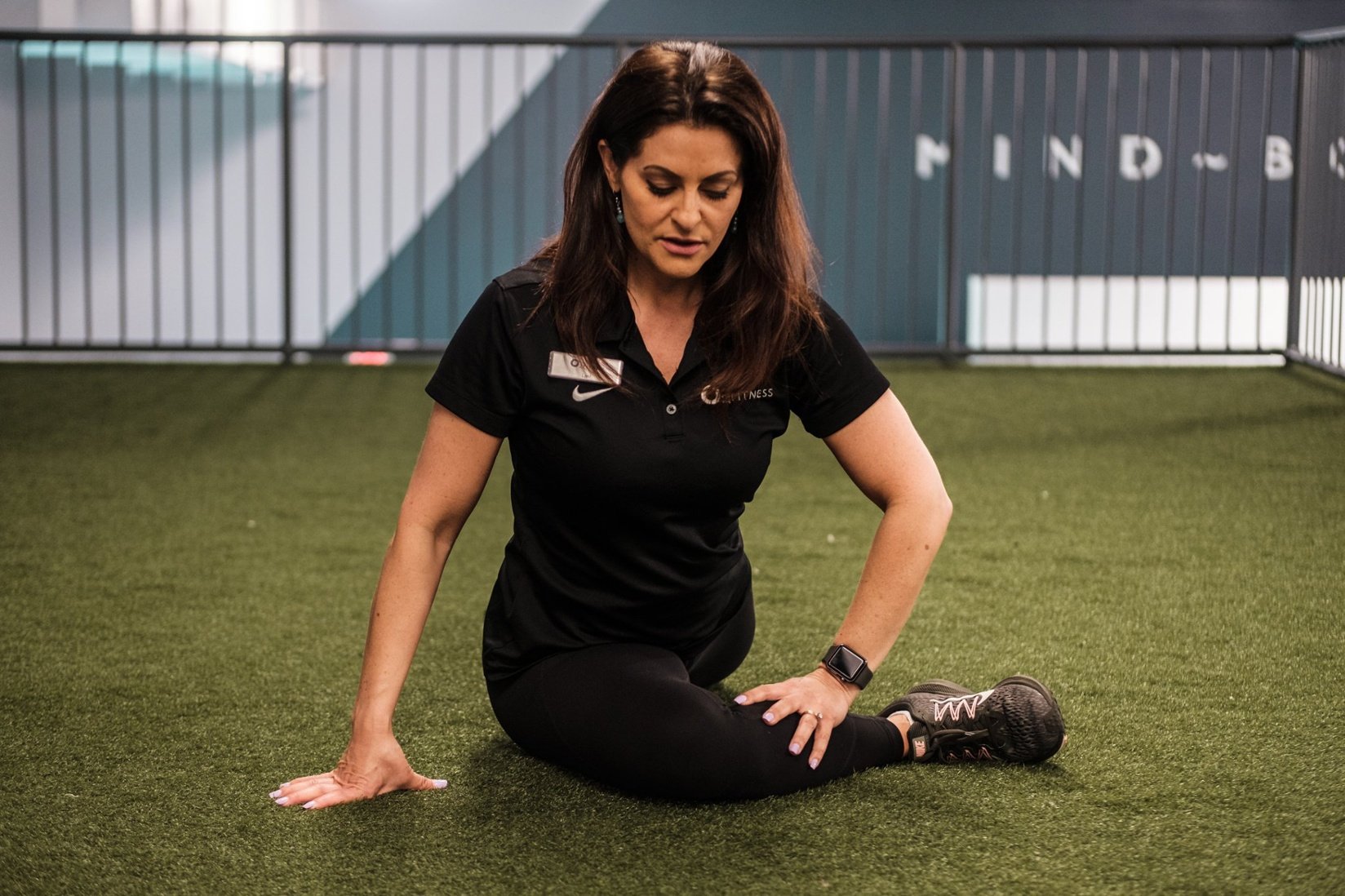Personal Trainer Onboarding Template (FREE)
Use this free personal trainer onboarding template to learn how to onboard personal training clients professionally.

Welcome to the ultimate guide on personal trainer onboarding! In this article, we will cover every aspect of PT client onboarding, from its importance to the benefits of using a personal trainer onboarding template (available free below).
Get ready to discover how to create an effective fitness client onboarding process, implement the free PT client onboarding template, customize it to suit your needs, and overcome common challenges. We will also explore the key elements to include in your personal training client onboarding checklist, streamline the process for efficiency and success, incorporate technology into your strategy, and enhance client engagement.

We’ll also discuss how to measure the success of your personal training client onboarding program, provide tips for training and educating new clients, and ensure smooth transitions from onboarding to regular training sessions.
Discover the ultimate personal trainer onboarding template to streamline your fitness business. And, of course, managing your fitness business with the best gym management software and the best personal training software means that you can easily create personal training client onboarding templates and checklists with automatic messages to send to clients with email, SMS, and in-app messaging marketing cadences, you can create fitness session plans, waivers, forms, fitness assessments, lead forms, registration forms, offer online booking, workout plans, and much more.

Use the Exercise.com workout plan creator to create your workout plans and fitness assessments.

Publish your custom branded fitness apps to iOS and Android so you can offer a premium experience to your community.

Run fitness challenges, create online workout groups, do distance training, and of course, deliver fitness assessments and workouts, all right within the Exercise.com platform (custom branded to your brand).


Personal Trainer Onboarding Template
Welcome to [Your Business/Your Name Personal Training]!
We are excited to have you on board and look forward to working together towards achieving your fitness goals. This onboarding template is designed to ensure a smooth start to our training journey and to provide you with all the necessary information to get started.
Personal and Contact Information
- Full Name:
- Date of Birth:
- Address:
- Phone Number:
- Email Address:
- Preferred Method of Contact (e.g., phone, email, text):
Health and Fitness Information
- General Health Questionnaire: [Attach or provide link to a health questionnaire to assess the client’s health status.]
- PAR-Q Form: [Attach or provide link to Physical Activity Readiness Questionnaire.]
- Fitness Goals: [Discuss and document the client’s short-term and long-term fitness goals.]
- Exercise History: [Gather information on the client’s previous exercise experience and current activity level.]
Administrative Details
- Payment Agreement: [Provide a copy of the payment agreement for review and signature.]
- Cancellation Policy: [Clearly explain the cancellation policy and any associated fees.]
- Emergency Contact Information: [Collect emergency contact details.]
Initial Assessment
- Schedule an Initial Fitness Assessment: [Set a date and time for an initial fitness assessment to gauge the client’s current fitness level and to further tailor the training program.]
- Measurement and Record Keeping: [Explain the process of regular progress tracking, including measurements, fitness tests, etc.]
Training Program Overview
- Expected Frequency of Sessions: [Outline the recommended number of sessions per week.]
- Duration of Each Session: [Specify the typical length of a training session.]
- Program Customization: [Discuss how the program will be customized to meet the client’s goals and needs.]
- Introduction to Training Methods: [Give a brief overview of the types of exercises, training methodologies, and equipment that will be used.]
Facility Orientation (If Applicable)
- Tour of Facilities: [Show the client around the gym, highlighting areas where training will take place.]
- Introduction to Equipment: [Provide a basic introduction to the equipment they will be using.]
Communication and Feedback
- Regular Check-Ins: [Set expectations for regular communication and feedback sessions.]
- Client Feedback Process: [Explain how and when clients can provide feedback on their training program.]
Next Steps
- Preparation for First Session: [Provide guidelines on what to bring, wear, and how to prepare for their first training session.]
- Welcome Pack: [If available, provide a welcome pack with additional resources, such as nutrition guides, workout logs, etc.]
Trainer Signature: ___________________________
Date: ____________
Client Signature: ____________________________
Date: ____________
This Personal Trainer Onboarding Template is designed to provide a comprehensive and organized start for new clients. It covers all essential aspects from personal information, health assessment, and administrative details to an overview of the training program and facility orientation. Tailoring this template to each client’s specific needs and goals will set the foundation for a successful and productive trainer-client relationship.
Read More:
- Gym Health Questionnaire Template
- Personal Trainer Questionnaire Template
- Gym PAR-Q Template
- Personal Trainer PAR-Q Template
Ready to automate your personal training business and send personal trainer proposals and forms electronically with online fitness assessments?

Why Onboarding Is Important for Personal Trainers
Personal trainer onboarding sets the foundation for a successful client-trainer relationship. It is the process of welcoming new clients and acclimating them to your training program. By investing time and effort in onboarding, you lay the groundwork for long-term client satisfaction and loyalty. Effective onboarding allows you to understand your client’s goals, preferences, and any limitations they may have. Additionally, it builds trust and rapport, creates realistic expectations, and ensures that both parties are aligned in their approach to achieving fitness objectives.
During the onboarding process, personal trainers have the opportunity to gather important information about their clients’ health history and any pre-existing conditions. This knowledge is crucial for designing personalized workout plans that are safe and effective. By understanding their clients’ medical background, trainers can modify exercises, recommend appropriate intensity levels, and avoid potential injuries.
Furthermore, onboarding provides an opportunity for personal trainers to educate their clients about proper form and technique. By teaching clients the correct way to perform exercises, trainers can help prevent injuries and maximize the effectiveness of each workout. This education empowers clients to continue their fitness journey with confidence, even when they are not working directly with their trainer.
The Benefits of Using a Personal Trainer Onboarding Template
Using a personal trainer onboarding template offers numerous advantages. Firstly, it enables consistency in the onboarding process, ensuring that every new client receives the same high-quality experience. Templates also save time and effort, as you don’t have to create onboarding materials from scratch for each client. They provide a clear structure and flow to guide you through each step, ensuring that no essential components are overlooked. Templates can be customized to reflect your unique training style, brand, and clientele, making them a valuable tool for both trainers and clients.
Additionally, personal trainer onboarding templates can help trainers establish a professional image and build trust with their clients. By providing a well-designed and organized onboarding experience, trainers can demonstrate their expertise and commitment to their clients’ success. Templates can include important information such as client goals, medical history, and fitness assessments, allowing trainers to gather all the necessary information to create personalized training programs. This level of detail and attention to individual needs can enhance client satisfaction and increase the likelihood of achieving desired results. Furthermore, using templates can also streamline communication between trainers and clients, as all relevant information is easily accessible and can be shared electronically. Overall, personal trainer onboarding templates are a valuable resource that can improve efficiency, effectiveness, and client satisfaction in the fitness industry.
Understanding the Components of a Personal Trainer Onboarding Template
A comprehensive personal trainer onboarding template typically includes several key components. These may include an initial consultation to gather information about the client’s goals, lifestyle, and health history. It may also include a fitness assessment to evaluate the client’s current fitness level and identify areas for improvement. Furthermore, the template may incorporate goal-setting exercises, a detailed training plan, nutrition guidance, and methods for tracking progress. Providing clear expectations, discussing scheduling and payment, and establishing effective communication channels are also essential components of the onboarding process.
In addition to these components, a personal trainer onboarding template may also include a section on injury prevention and safety. This can involve educating the client on proper form and technique during exercises, as well as providing guidelines for warm-up and cool-down routines. The template may also outline protocols for handling emergencies or injuries that may occur during training sessions.
Another important aspect that may be covered in a personal trainer onboarding template is client education. This can involve providing information on the benefits of regular exercise, the importance of proper nutrition, and the role of rest and recovery in achieving fitness goals. The template may include resources such as articles, videos, or recommended reading materials to further educate and empower the client in their fitness journey.
How to Create an Effective Personal Trainer Onboarding Process
To create an effective personal trainer onboarding process, start by defining your goals for the onboarding experience. Consider what you want to achieve and how onboarding can support those objectives. Next, evaluate your existing practices and identify areas for improvement. Use this information to design a step-by-step process that encompasses vital components like consultation, assessment, goal setting, and communication. Incorporate your brand messaging and training philosophy into the onboarding materials, ensuring they reflect your unique approach and values. Regularly review and update your onboarding process to keep it relevant and aligned with industry best practices.
One important aspect to consider when creating an effective personal trainer onboarding process is the role of technology. Utilizing digital tools and platforms can streamline the onboarding experience, making it more efficient and convenient for both trainers and clients. For example, you can use online forms or software to collect client information, schedule appointments, and track progress. Additionally, incorporating virtual training sessions or video tutorials into the onboarding process can provide clients with flexibility and accessibility.
Another key factor to address in your onboarding process is the importance of building rapport and trust with clients. Personal training is a highly personalized service, and clients need to feel comfortable and confident in their trainer’s abilities. Consider incorporating icebreaker activities or introductory sessions to establish a connection with clients from the beginning. Additionally, providing clear and consistent communication throughout the onboarding process can help build trust and ensure clients feel supported and informed.
Step-by-Step Guide to Implementing a Personal Trainer Onboarding Template
Implementing a personal trainer onboarding template involves the following steps:
- Choose a template that suits your training style and clientele.
- Customize the template to reflect your branding and values.
- Review and revise the template’s components as needed.
- Train your team (if applicable) on using the template effectively.
- Introduce the onboarding process to new clients, explaining its purpose and benefits.
- Guide clients through each step of the onboarding process, ensuring their understanding and involvement.
- Solicit feedback from clients to continuously improve the onboarding experience.
Remember, the template is a flexible tool, so feel free to adapt it to better suit your unique requirements and goals.
Once you have successfully implemented the personal trainer onboarding template, you can start reaping the benefits. One of the key advantages is that it helps streamline the onboarding process, saving you time and effort. By having a standardized template in place, you can ensure that each new client receives the same level of attention and information, leading to a consistent and positive experience.
Additionally, the onboarding template can help you establish a strong foundation for your client-trainer relationship. By guiding clients through the onboarding process, you can build trust and rapport right from the start. This can lead to better communication, increased client satisfaction, and ultimately, improved client retention rates.
Best Practices for Customizing Your Personal Trainer Onboarding Template
When customizing your personal trainer onboarding template, keep in mind these best practices:
- Ensure your branding is consistent across all materials.
- Personalize the template with the client’s name and specific goals.
- Make the content engaging and easy to understand.
- Include visuals and graphics to enhance comprehension.
- Consider adding motivational quotes or success stories.
- Review and update the template periodically to keep it current.
By following these practices, you can create a more personalized and impactful onboarding experience for your clients.
Common Challenges in Personal Trainer Onboarding and How to Overcome Them
Personal trainer onboarding can be challenging due to various factors, such as client expectations, time constraints, and organizational issues. To overcome these challenges:
- Set clear expectations with clients regarding what they can expect during onboarding.
- Establish a timeline that allows for a thorough but efficient onboarding process.
- Streamline administrative tasks by leveraging technology and automation.
- Provide ongoing support and communication throughout the onboarding period.
- Regularly evaluate and refine your onboarding process to address any areas of improvement.
Key Elements to Include in Your Personal Trainer Onboarding Checklist
When creating your personal trainer onboarding checklist, consider including the following key elements:
- Client information collection (e.g., contact details, health history).
- Initial consultation and goal setting.
- Fitness assessment and baseline measurements.
- Training plan development and customization.
- Nutrition guidance and meal planning (if applicable).
- Evaluation and progress tracking methods.
- Communication channels and expectations.
By including these elements in your checklist, you ensure a comprehensive and well-rounded onboarding experience for your clients.
Streamlining Your Personal Trainer Onboarding Process for Efficiency and Success
To streamline your personal trainer onboarding process, consider the following strategies:
- Automate administrative tasks, such as client information collection and scheduling.
- Utilize online platforms and tools for virtual consultations and assessments.
- Create standardized templates and materials for easy customization and replication.
- Implement a client management system to centralize communication and track progress.
- Train your team (if applicable) on efficient onboarding practices.
By adopting these strategies, you can enhance the efficiency and scalability of your onboarding process, leading to greater success and client satisfaction.
Incorporating Technology into Your Personal Trainer Onboarding Strategy
In today’s digital age, incorporating technology into your personal trainer onboarding strategy is essential. Consider using tools like online forms, video conferencing platforms, fitness tracking apps, and communication software to streamline your onboarding process. These technologies can enhance client engagement, automate administrative tasks, and create a seamless and convenient onboarding experience for your clients.
Enhancing Client Engagement through an Effective Onboarding Experience
An effective onboarding experience is instrumental in enhancing client engagement. Here are some strategies to achieve this:
- Actively listen to clients’ needs and goals during the onboarding process.
- Provide educational resources and materials to empower clients.
- Offer regular check-ins and progress evaluations to maintain client motivation.
- Personalize the training plan to align with clients’ preferences and interests.
- Encourage open communication and create a supportive environment.
By prioritizing client engagement during onboarding, you set the stage for a long-lasting and successful client-trainer relationship.
Measuring the Success of Your Personal Trainer Onboarding Program
Measuring the success of your personal trainer onboarding program is crucial to evaluate its effectiveness and make informed improvements. Some metrics to consider include:
- Client retention rates.
- Client satisfaction surveys.
- Progress towards clients’ goals.
- Client referrals and positive testimonials.
- Efficiency of onboarding process (e.g., time spent, resources used).
Regularly analyze these metrics to identify areas of strength and areas that may require further attention, allowing you to continuously enhance your onboarding program.
Tips for Training and Educating New Clients during the Onboarding Phase
During the onboarding phase, it’s essential to effectively train and educate new clients to set them up for success. Consider the following tips:
- Create clear and concise training guides or manuals.
- Use visual aids like videos or infographics to demonstrate exercises or techniques.
- Provide ongoing feedback and correction during training sessions.
- Encourage post-training reflection and goal review.
- Schedule regular check-ins to address questions and concerns.
By implementing these tips, you can ensure that new clients feel confident and supported as they embark on their fitness journey with you.
Ensuring Smooth Transitions from Onboarding to Regular Training Sessions
The transition from onboarding to regular training sessions is a critical point in the client-trainer relationship. To ensure a smooth transition:
- Clearly communicate the purpose and timeline of the onboarding phase.
- Provide a clear outline of what to expect in regular training sessions.
- Gradually shift from a structured onboarding approach to a more personalized training plan.
- Offer ongoing support and check-ins to address any concerns or obstacles.
By managing this transition effectively, you can maintain client enthusiasm and motivation throughout their entire fitness journey with you.
Congratulations! You’ve reached the end of this comprehensive guide on personal trainer onboarding. By implementing the knowledge and strategies shared here, you can create an exceptional onboarding experience for your clients, laying the foundation for long-lasting success and satisfaction. Remember, a well-crafted onboarding process is the key to building strong client-trainer relationships and helping your clients achieve their fitness goals. Now go out there and make a lasting impact!
What is the onboarding process in personal training?
The onboarding process in personal training involves introducing new clients to your training programs, assessing their fitness levels and goals, discussing their health and medical history, and setting expectations for the training journey. This process is crucial for establishing a strong trainer-client relationship.
How do you onboard fitness clients?
Onboarding fitness clients includes conducting initial consultations to understand their goals and background, performing fitness assessments, discussing training plans and schedules, and setting clear goals and expectations. It’s also important to familiarize clients with the gym facilities and policies.
How do you introduce yourself as a personal trainer?
Introduce yourself as a personal trainer by sharing your qualifications, experience, training philosophy, and success stories. Be approachable and express enthusiasm for helping the client achieve their fitness goals. Building rapport and trust from the outset is key.
How do I start a new client in personal training?
Start a new client in personal training by conducting a thorough assessment of their fitness level, understanding their goals and any limitations, and then creating a tailored training plan. Ensure clear communication and build a comfortable environment for them to begin their fitness journey.
What makes a good personal training client onboarding?
A good personal training client onboarding experience is thorough, personalized, and sets a positive tone for the training relationship. It should involve a detailed assessment, clear goal setting, and an introduction to the training approach and expectations.
What is the first thing a personal trainer should do with a new client?
The first thing a personal trainer should do with a new client is to conduct an initial consultation to discuss the client’s goals, health history, and any concerns or preferences they have regarding their fitness journey. This helps in creating a personalized training plan.
What should happen in the first personal training session as a trainer?
In the first personal training session, the trainer should start with a warm-up, possibly conduct a basic fitness assessment, introduce the client to basic exercises, and gauge their fitness level. This session should also be used to build rapport and provide motivation.
How can Exercise.com help streamline a personal training business?
Exercise.com can help streamline a personal training business by offering comprehensive software solutions for client management, workout programming, scheduling, tracking progress, and billing. Its platform allows trainers to efficiently manage their clients, customize training plans, and automate various aspects of their business, enabling them to focus more on training and less on administrative tasks.










